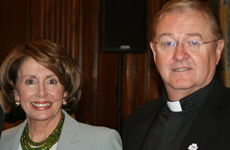Leadership contests generate party support
Posted By: June 05, 2017
IRISH CONGRESSIONAL BRIEFING
“One of the more surprising features of the Fine Gael contest was the emphasis on the north and the possibility of a united Ireland. We can thank the Brexit referendum vote for the renewed emphasis on Irish unity which had not been a serious issue in the mainstream politics of the southern part of this island for decades.”
Deaglan de Breadun. Irish News. Belfast. Monday, June 5, 2017
There is a lesson for Sinn Féin and the Irish Labour Party in the recent contest for the leadership of Fine Gael.
Leo Varadkar wasn’t the only winner: his party benefited considerably and the unsuccessful candidate, Simon Coveney, also emerged with a good deal of credit.
Journalists revel in these gladiatorial encounters and, for weeks now, political coverage has been dominated by the “Blueshirts” – with Fianna Fáil and Sinn Féin basically watching from the opposition sidelines. From December 2016 until the end of April this year, Fianna Fáil were number one in 10 out of 11 opinion polls. But in two surveys published in May, Fine Gael was ahead – in one case by eight points. Over the last year-and-a-half, Sinn Féin has been in third place, well ahead of Labour but not overtaking the two main parties except for one poll that had them slightly ahead of Fine Gael.
The lesson for Sinn Féin and indeed other parties is that having open and public leadership contests generate public interest and support. The contrast between the Fine Gael battle and the appointment of Michelle O’Neill in the north was stark. It would have been a good idea also for Labour to facilitate a leadership race between Brendan Howlin and Alan Kelly but none of Kelly’s TD colleagues was prepared to second his nomination, leaving Howlin as the sole candidate. The lack of a competition is part of the reason Labour has languished between four and seven percent since the end of 2016.
A series of “hustings” or debates was organized at different locations between the two Fine Gael contenders and the media were invited as observers. With other journalists, I attended the one that took place in Dublin. There was quite a buzz in the air: the large auditorium was packed to the doors and the overflow had to sit in the corridor outside. The debate was also carried on Facebook.
For the first time, ordinary members and local councilors were given a vote on the leadership although TDs, Senators, and MEPs received a higher weighting at 65 per cent whereas the members and councilors accounted for 25 and 10 per cent respectively. Since the new leader is to be proposed for the office of Taoiseach on June 13, the Fine Gael membership was also helping to choose the head of government.
Historically, Fine Gael has had a rather bourgeois image with a high proportion of lawyers in its parliamentary party. It was seen as the voice of the big farmers and upper-middle class. That has definitely changed, in terms of both the parliamentary party and the membership and this was reflected in the audience at the Dublin hustings. Admittedly, Varadkar and Coveney come from privileged backgrounds but, as a colleague humorously observed, “It’s not their fault.”
Fine Gael has been eating into the lower-middle and “middle-middle” class element of Fianna Fáil’s support. For its part, Sinn Féin has attracted a high proportion of Labour’s working-class vote. Fianna Fáil traditionally had a strong base in that sector also but appears to be losing some of it to Adams & Co.
One of the more surprising features of the Fine Gael contest was the emphasis on the north and the possibility of a united Ireland. We can thank the Brexit referendum vote for the renewed emphasis on Irish unity which had not been a serious issue in the mainstream politics of the southern part of this island for decades.
In a “policy ideas paper”, Leo Varadkar stated: “We need to prepare for the possibility that a United Ireland or shared sovereignty will occur in our lifetime.” The paper added that “lasting workable unity” could only come about with support from both communities in The North and he opposed a Border Poll at this time. For his part, Simon Coveney said Fine Gael should draft “a White Paper on possible reunification” to be published ahead of the party’s ard-fheis/conference in November.
Some observers are now predicting an early general election, perhaps also in November. Their reasoning is that public opinion tends to be well-disposed, however briefly, to a newly-installed Taoiseach and that Fine Gael will not wait until that goodwill has evaporated. Others caution that the annual budget due in October will not be a vote-getter as there is a scarcity of funds in the state coffers.
Outgoing Taoiseach Enda Kenny was possessed of considerable patience and this was a factor in sustaining the minority government set up under an agreement with Fianna Fáil on the opposition benches. Kenny’s successor may not be so forbearing and might well decide to go to the country in the short term.
As baseball legend Yogi Berra famously said: “When you come to a fork in the road, take it.”
@ddebreadun










